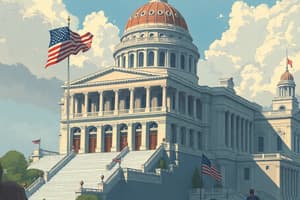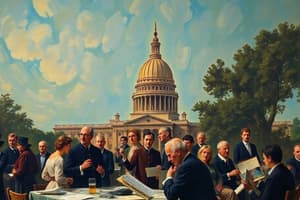Podcast
Questions and Answers
What is the primary role of a standing committee in Congress?
What is the primary role of a standing committee in Congress?
- To focus on specific policy areas and hold regular meetings (correct)
- To represent the interests of individual constituents
- To lead the House of Representatives
- To hold the final vote on major legislation
What does the term 'filibuster' refer to in the context of the Senate?
What does the term 'filibuster' refer to in the context of the Senate?
- A strategy to delay a vote by making long speeches (correct)
- A formal vote to end a legislative session
- A process for redefining congressional districts
- A committee that reconciles differences in legislation
Which of the following best defines the term 'veto'?
Which of the following best defines the term 'veto'?
- To amend a bill before a vote
- To approve a bill passed by Congress
- To delay the consideration of a bill
- To reject a bill passed by Congress (correct)
What is the purpose of exit polls?
What is the purpose of exit polls?
How does descriptive representation differ from collective representation?
How does descriptive representation differ from collective representation?
What is the function of conference committees?
What is the function of conference committees?
Which statement accurately describes the Speaker of the House?
Which statement accurately describes the Speaker of the House?
What do caucuses primarily focus on during political meetings?
What do caucuses primarily focus on during political meetings?
What is a safe state in the context of presidential elections?
What is a safe state in the context of presidential elections?
What does veto bargaining involve?
What does veto bargaining involve?
What was the primary goal of the Pendleton Act?
What was the primary goal of the Pendleton Act?
What does the term 'agency drift' refer to?
What does the term 'agency drift' refer to?
What is the function of an amicus curiae in legal proceedings?
What is the function of an amicus curiae in legal proceedings?
What does the 'Rule of Four' establish?
What does the 'Rule of Four' establish?
What defines a majority opinion in a court ruling?
What defines a majority opinion in a court ruling?
In what way does bureaucratic discretion impact the implementation of laws?
In what way does bureaucratic discretion impact the implementation of laws?
What is the significance of a judicial precedent?
What is the significance of a judicial precedent?
How does originalism approach constitutional interpretation?
How does originalism approach constitutional interpretation?
Flashcards
Collective Representation
Collective Representation
The extent to which Congress's policies reflect the views of a majority of Americans.
Constituent Representation
Constituent Representation
How well individual lawmakers represent the interests of their constituents (residents of their district or state).
Constituent Service
Constituent Service
Direct assistance that members of Congress provide to their constituents, such as helping with government programs or resolving issues with federal agencies.
Descriptive Representation
Descriptive Representation
Signup and view all the flashcards
Speaker of the House
Speaker of the House
Signup and view all the flashcards
Standing Committee
Standing Committee
Signup and view all the flashcards
Filibuster
Filibuster
Signup and view all the flashcards
Cloture
Cloture
Signup and view all the flashcards
Safe States
Safe States
Signup and view all the flashcards
Swing States
Swing States
Signup and view all the flashcards
Veto Bargaining
Veto Bargaining
Signup and view all the flashcards
Executive Orders
Executive Orders
Signup and view all the flashcards
Spoils System
Spoils System
Signup and view all the flashcards
Political Appointees
Political Appointees
Signup and view all the flashcards
Pendleton Act
Pendleton Act
Signup and view all the flashcards
Hatch Act
Hatch Act
Signup and view all the flashcards
Bureaucratic Discretion
Bureaucratic Discretion
Signup and view all the flashcards
Agency Drift
Agency Drift
Signup and view all the flashcards
Study Notes
Congressional Representation
- Collective representation: The extent to which Congress' actions reflect the majority opinion of the US population.
- Constituent representation: How well individual legislators serve the interests of their constituents (district/state residents).
- Constituent service: Direct assistance provided by members of Congress to their constituents.
- Descriptive representation: Matching of elected officials' demographics with those of the citizenry.
Congressional Processes
- Speaker of the House: Leader of the House, chosen by the majority party.
- Standing committee: Permanent House committees focused on specific issues.
- Filibuster: Senate tactic of prolonged speaking to delay or block votes.
- Cloture: A Senate procedure requiring 60 votes to end a filibuster and force a vote.
- Conference Committees: Joint House-Senate committees to reconcile differing versions of bills.
- Veto: Rejection of a bill by the President.
Presidential Power and Procedures
- Veto bargaining: Using the veto as leverage in policy negotiations.
- Executive orders: Directives from the President to manage government operations (no Congressional approval needed).
- Spoils system: Awarding government jobs based on political loyalty (historical).
- Political appointees: Government positions filled by people loyal to the President.
- Pendleton Act: Law ending the spoils system, focusing on merit-based hiring.
- Hatch Act: Limits political activity of federal employees.
Bureaucracy and Congressional Oversight
- Bureaucratic discretion: Power of bureaucrats to interpret and apply laws.
- Procedural politicking: Bureaucrats influencing rulemaking outcomes.
- Congressional oversight: Congress' power to investigate and monitor agencies.
- Principal-agent problem: When agents (bureaucrats) act differently from principals (Congress) intentions.
- Agency drift: Bureaucrats deviating from Congressional intent in policy implementation.
- Rulemaking authority: Power to shape regulations for law implementation.
Elections and Public Opinion
- Caucus: Voter meetings selecting presidential candidates.
- Primary Election: Voters choose party candidates for the general election.
- Exit polls: Surveys of voters directly after voting, revealing election and issue priorities.
- Electoral College: The Constitution's presidential election system.
- Safe states: States where electoral outcomes are usually certain.
- Swing states: States with highly competitive elections.
The Judiciary
- Civil case: Dispute between individuals/businesses, typically over money.
- Plaintiff: Person filing a lawsuit.
- Defendant: Accused party in a case.
- Appellate court: Court reviewing decisions from lower courts (court appeals).
- Amicus curiae: "Friend of the court," interested parties submitting briefs.
- Writ of certiorari: Order for an appellate court to review a lower court decision.
- Rule of four: Supreme Court practice needing four justices to accept a case.
- Majority opinion: Binding court decision.
- Dissenting opinion: Opinion disagreeing with the majority.
- Precedent: Court ruling influencing future similar cases.
- Living constitution: Interpreting the Constitution based on modern values/principles.
- Originalism: Interpreting the Constitution as its framers intended.
Studying That Suits You
Use AI to generate personalized quizzes and flashcards to suit your learning preferences.
Description
This quiz explores concepts of congressional representation, including collective and descriptive representation, as well as key legislative processes such as the roles of the Speaker of the House, filibuster tactics, and committee functions. Test your understanding of how Congress serves its constituents and the mechanisms it employs to pass laws.




